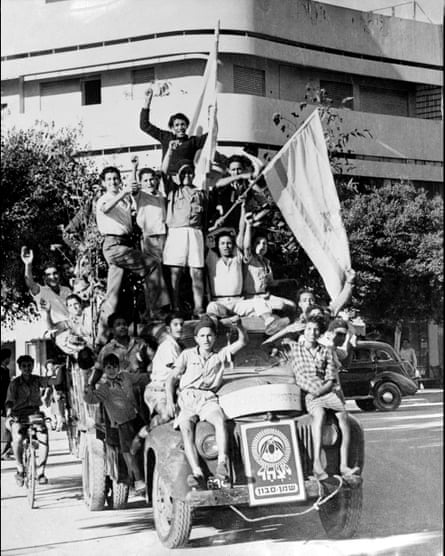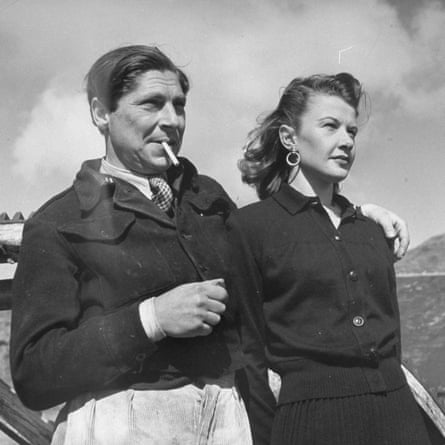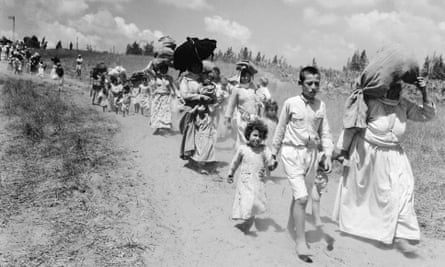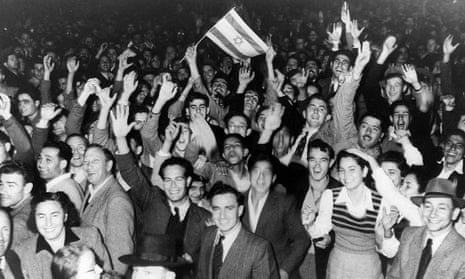‘In the beginning was chaos and muddle,” reads the first line of the June 1948 dispatch from the coastal city of Tel Aviv. The state of Israel was less than a month old when the Manchester Guardian launched a series of articles by the journalist and novelist Arthur Koestler. The country had declared independence on 14 May.
In the midst of a conflict with Arab Palestinians, coupled with an invasion by surrounding states, Israel had no clearly accepted borders but was hastily forming a government. So young was the country that the Israeli visas stamped on Koestler’s and his partner’s passports in Paris were numbered five and six. On arrival, he found airport signs freshly painted in English and Hebrew, while immigration and customs officers had not yet received uniforms.

“Here is bureaucracy in a state of virginal innocence before it has had time to spin itself into a cocoon of red tape,” wrote Koestler in his first article, titled “Israel: First Impressions”. Seventy years ago, Koestler had published Darkness at Noon (1940) and was established as a buccaneering leftwing intellectual and close friend of George Orwell. He arrived to an Israel vastly unrecognisable from the regional powerhouse it is today. Notwithstanding open conflict, Israel’s untested leaders were gathering Jewish militant factions into one army and forming a nation of disparate Jews from across Europe and the Middle East. After close to three decades in which the territory had been under the British Mandate for Palestine, the United Nations proposed, in 1947, to split the area into two, forming independent Arab and Jewish states. Civil war erupted, and Jewish leaders later announced Israel’s creation.
“The first year or two of Israel’s existence will be decisive for its future, and it depends on its leaders who have resurrected the Jewish State against almost impossible odds,” wrote Koestler.
Born in Hungary in 1905 to Jewish parents, Koestler had embraced a myriad of 20th-century political movements, describing himself as the “Casanova of Causes”. Sometime communist, anti-fascist, anti-death penalty and pro-euthanasia, Koestler was captured by Franco’s forces in the Spanish civil war in the late 1930s, and narrowly avoided being executed after he was arrested for spying. Later, in 1940, he managed to escape from the Nazis when they invaded France, and made his way to Britain. Despite all this, chief among his political obsessions may have been the establishment of the Jewish state. Koestler, who first travelled to Palestine in 1926 as a Jewish settler, once described himself as a “young duel-fighting Zionist”.
A controversial malcontent, the writer was known to be a manipulative sexual predator, and an alleged rapist (Michael Foot’s wife, Jill Craigie, was one of his alleged victims, confirming a claim made in a 1999 biography). Further contention was added to his record after he and his wife killed themselves in 1983, even though she was healthy and years younger than him. Police found the pair seated in chairs in the living room of their Knightsbridge home.

Koestler began his Israel dispatches in deserted Haifa, a Mediterranean town where, weeks before his arrival, he reported that most of the port city’s 70,000 Arabs had fled amid fierce fighting with Jewish forces. Koestler’s take was that “it fell because the Arab population, though only slightly inferior in numbers and superior in arms, were utterly demoralised through the desertion of their leaders”. The Haganah, a Jewish paramilitary organisation that went on to become the Israel Defense Forces, had broadcast in Arabic the names of the deserters to demoralise the Arab gunmen, he wrote.
Arabs featured only occasionally in Koestler’s articles. “The native Palestine Arabs,” he said, “never fought seriously because they had no reason for fighting, having accepted the presence of the Jews with its economic benefit and the de facto partition as accomplished facts.” Travelling down the coastal road from Haifa to Tel Aviv, Koestler said his view was “confirmed” by Arab farmers in Israel who he said were “unmolested” while being treated “with equanimity and trading produce with Jews”. It was not clear if he had stopped to speak to them.
Anita Shapira, an Israeli historian who has focused on the early years of statehood, says this “very idyllic description of farmers working in the fields baffled me. It was far from reality. We are talking about almost 10 months of civil war between the Palestinians and the Jews, and then a month of fighting with the Arab states. I don’t think anybody could have imagined idyllic relations between Jews and Arabs at that time.”
More than 700,000 Palestinians fled or were driven from their homes in the war surrounding Israel’s creation – an event that is commemorated by Palestinians every year on 15 May as the Nakba, or “catastrophe”. Tens of thousands of Palestinians stayed and make up about a fifth of Israel’s modern-day population.
Eman Abu Hanna-Nahhas, who has written a PhD on the collective memory of the Nakba for Palestinians, says the relationship with Arabs remaining inside Israel, many of whom were internally displaced, varied significantly. “When you are defeated and you know that you’ve lost your home, I’m not sure you would have good relations,” she says. Other Palestinians who had fled but were trying to return to the new state were blocked. But, she adds, in other cases there was amicability.

One of the only times an Arab source did appear in Koestler’s reports was when he interviewed two Egyptian prisoners who, he said, “displayed about the lowest morale I ever saw among combatants in any army”.
Koestler had already written much on Palestine, including Thieves in the Night, a novel inspired by his experiences in an agricultural kibbutz. A 1946 review in the New York Times called it “editorial, angry and partisan”. It added: “There is never a time when [the book’s Jewish settler protagonist] questions the right of his people to dominate the land in which the Arabs are and have long been in a majority.”
After he returned to Israel in 1948, Koestler described what he said was a “mystical fervour” among the state’s improvised army: “Native Jewish Tarzans throw homemade Molotov bombs on tanks from the tops of eucalyptus trees or jump at turrets blowing themselves up.” Many of his reports centred on the Jewish forces being haphazardly collated into one military, with sporadic “fratricide struggle” between bitter rivals.
One story, titled “Trouble in Israel”, covered the sinking of the Altalena cargo ship, which was the focus of a confrontation between the Irgun, a rightwing Jewish paramilitary group, and the nascent army. Sixteen men were killed and scores wounded when gunboats of the Israeli navy fired on and grounded the ship, which the Irgun had used to transport arms. Koestler quotes one of the civilian passengers, a woman who had travelled from France to immigrate to the new state: “I gave up my studies to help defend the Jewish State. While approaching the shore we were received by the fire of Jewish guns and four of us were killed. This ends all hope.”

Koestler contrasts what he said was a moderate Haganah with the “terrorist” Irgun and Lehi militants, whom he described as religiously motivated extremists who “fought with uncompromising fanaticism, committed murder, and walked cheerfully to the gallows, with some savage Psalm of David on their lips”.
Operating underground during British rule, in 1946 the Irgun had blown up the southern wing of Jerusalem’s iconic King David hotel, killing 91. And, in September 1948, Koestler reported the assassination by Lehi of Count Folke Bernadotte, the UN peace mediator.
The heavy-handed response to the Altalena incident, Koestler wrote, was down to an insecure leadership, which he said “suffers from an inferiority complex and is obsessed with asserting its authority”. “Like a young school teacher facing an unruly class it is reverting to unnecessarily draconian measures,” he wrote. “This situation is aggravated by the fact that the government is not elected but self-appointed and is displaying embryonic tendencies towards dictatorship.”
The provisional prime minister, David Ben-Gurion – who Koestler said ran the country with “paternal despotism” – would go on to lead Israel for a total of 13 years, although not consecutively; his political allies remained in power until the late 1970s.
Shapira says there was never a concern that Israel would not hold elections, which were planned for and took place a year after Koestler’s visit. “Dictatorship was never an option,” she says. “However, Ben-Gurion was not a very tolerant person, especially on the issue of authority.” For him, she says, it was essential that the state had a monopoly on the use of force.
Koestler later turned his back on Israel (where he is viewed disfavourably to this day), but in 1948 he was bursting with Zionist zeal. Nevertheless, he found Israel “aesthetically” disappointing. He appeared to hold a particular dislike for Tel Aviv, then a city of about 200,000 people whose apartments had sprung up swiftly following waves of migration. “Tel Aviv’s architecture is the drab functionalism of the early 20s at its worst. The streets have no skyline; the seafront is hemmed in by a row of sordid little cafes with blaring loud-speakers,” he wrote. “As for the countryside, no greater contrast is imaginable than that between the picturesque squalor of the Arab villages, now mostly dead and deserted, and the sober purposefulness of Jewish settlements,” he added.
Israel, he concluded towards the end of his seven-month assignment, “is both a hard pioneer country and a bitter refugee country, disillusioned by experience, stubbornly fighting for life, with an aching void in its past and an interrogation mark for its future”.
